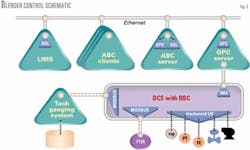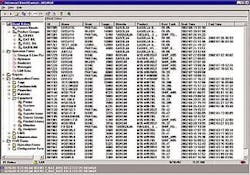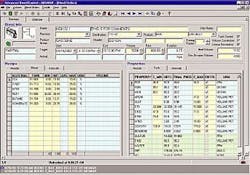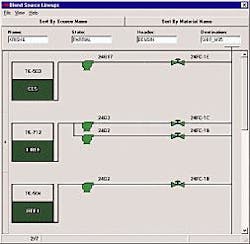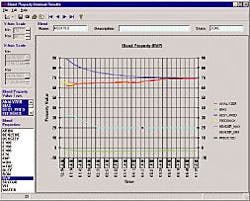Swedish refiner installs advanced blend control system
In 2001, Preem Petroleum AB commissioned an advanced blend control system at its Gothenburg, Sweden, refinery (Fig. 1). Preem wanted to modernize its blending process, blend more economically, and adapt to stringent and constantly changing European product specifications.
Preem selected ABB Inc. to supply the blend system, which includes online optimization using continuous analyzer feedback. Since commissioning, Preem has reduced the blend cost, production time, and number of blend corrections.
The blend package supplied by ABB includes:
Fourier transform infrared (FTIR) analyzer for online, continuous measurement of key blend properties.
Advanced blend control (ABC) for blend order creation, offline optimization, blend order management, online property control and optimization, tank property integration, and client-server communication.
- Regulatory blend control (RBC) for base regulatory, ratio, and sequential control.
- Distributed control system (DCS) for monitoring, operation, control, and interface to all plant field instrumentation.
Project scope
The project included ABC, RBC, and DCS upgrades for three separate blenders. To minimize the initial investment, only the gasoline blender received an online FTIR analyzer and online optimization.
Preem commissioned the advanced blend solution in October 2001. Since then, blend production time has been reduced by more than 30%, and most blends are produced with no property violation and minimum giveaway.
null
The ABC software package provides a Windows interface for planning and executing daily blend orders for gasoline, gas oil, and fuel oil. It also enables Preem to maintain the software by adding new equipment, components, and products, and to fine-tune blend parameters without outside assistance during plant or operational changes.
The software also allows Preem to meet and adapt to different product specifications in Europe.
The planning group creates blend orders in ABC and approves them for download and execution by the operations group using the RBC software. Preem personnel optimize the blends based on costs provided by the refinery's financial group.
Laboratory tank analyses and inventories interface to ABC from the refinery laboratory information management system (LIMS) and tank information management system (TIMS), respectively. Security features in ABC allow different refinery groups to log in and monitor blends without accidental interference, which improves communication and coordination in the blend planning and execution work flow.
Preem laboratory and ABB personnel calibrated the FTIR analyzer to measure research octane number (RON), motor octane number (MON), rvp, and other blend properties.
Preem refinery
The 100,000-b/sd Gothenburg refinery was originally owned and commissioned by BP PLC.
null
Main processing units that supply components for blending gasoline include a crude distillation unit, hydrotreaters, catalytic reformer, isomerization unit, and reformate splitter.
These units provide isomerate, reformate, light reformate, heavy reformate (TREF), and butane for gasoline blending. Catalytic cracked spirits and methyl tertiary butyl ether (MTBE) are purchased from external sources.
Preem currently has three blend headers for gasoline, gas oil, and fuel oil. It blends more than 22 components and produces more than 20 products and 100 grades for different countries in Europe.
Blending equipment consists of about 65 component tanks, 33 product tanks, 22 flow stations, and 29 pumps.
The blend headers have booster pumps to blend product directly to a product tank or ship in a harbor 6 km away. Product lines to the harbor have significant holdups that usually require flushing to the previous destination with the initial flow of current blend product.
The blend header and pumps also transport other refinery products to the harbor. Before blending a new product, therefore, Preem must backflush the product line with an existing blend product with similar properties.
Preem previously used offline optimization to blend gasoline, gas oil, and fuel oil. The property correlations in Excel-based optimizers were outdated due to new units and components. This resulted in a large difference between actual blend properties and those predicted by the offline optimizer.
null
Preem would use laboratory analyses to correct the blend recipe; blending was suspended until the laboratory calculated the results. In addition to lost production time, this approach resulted in frequent property violations and giveaway in the blended product.
System overview
Fig. 2 shows the overall architecture for the integrated blending control system.
The RBC resides in the DCS and interfaces with field instrumentation.
The ABC resides in a Windows NT server and interfaces with the DCS. It also interfaces with the refinery LIMS database. The program reads process and operating information, product analyzer measurements, and component lab data and downloads optimized recipes to the RBC.
ABC overview
Planning and operations personnel can create, optimize, execute, and store individual blend orders. The ABC system can also receive blend orders from offline multiblend optimization, planning, and scheduling systems.
ABC downloads the approved blend orders to the RBC for execution. Once on-line, the ABC blends products to meet product specifications at the lowest cost.
Primary elements of ABC are a relational database, a graphical user interface, a nonlinear modeling-optimization kernel, background calculation programs, and interfaces to outside systems. It also provides a reporting package and security system.
Relational database
A large amount of data is needed to specify, monitor, and optimally control a blend. ABC uses a relational data model to organize and store data so that users can view, enter, and update items, and programs can read and write efficiently.
Equipment associated with each blender includes the header, flow controllers, meters, and totalizers; header and component line analyzers; pumps and associated block valves; tanks with associated block valves; and other minor pieces of equipment.
The ABC database includes tables for defining the component and product materials, their types (e.g., gasoline or diesel), and associated properties and specifications.
Each material has properties, such as RON, MON, and rvp, that are defined in the ABC database. This includes relationships to control how the properties are used.
The blend order is the core of the ABC data model. A blend order entails all information associated with a particular blend, including input information needed to create the blend order and information collected and calculated throughout the blend's optimization and execution.
A completed blend order, therefore, contains a large amount of data. Each blend order includes a unique ID; the product and grade; a copy of the specifications; a list of component tanks or rundown streams; the destination tank, ship, or pipeline; properties of the destination tank before and after the blend; results of optimization executions; and lab results used for final tank certification.
Graphical user interface
Data stored in the ABC relational database are displayed in Visual Basic forms, which allow the user to access, enter, or delete data safely, without an understanding of the underlying database or Oracle software.
The ABC display allows engineering, planning, and operations personnel to work from their own computers.
The ABC navigator display (Fig. 3) provides a tree structure for access to all operations and configuration displays. Preem can select blend orders according to product group or status.
Users can view all displays in the navigator; however, only approved users can make changes in displays.
ABC provides displays for database configuration. Aside from common, project default settings (e.g., units of flow, calculation tolerances), most data are entered in tabular forms (Fig. 4).
The primary operational display is the blend order display, which allows Preem to create, modify, and monitor blend orders. It contains all relevant information including the target and actual blend rates, volumes, components and recipes, and blend properties and specifications.
Different tabs show recipes and properties for the header, tank, or all blend intervals.
The optimizer tab shows interval and average recipes, minimum and maximum recipe constraints, minimum and maximum header targets, predicted header properties, feasibility status of the optimizer run, etc.
null
Fig. 5 is a component equipment lineup display that operators use to change pump or flow-station selection before downloading the blend order.
Fig. 6 is a property trend including analyzer value, bias, tank prediction, optimizer minimum and maximum header target, feedback, etc.
Modeling-optimization kernel
ABC primarily performs pre-blend and online optimization. This optimization requires blend models in combination with an optimizer.
Blend models calculate the properties that result from a recipe. The optimizer solves for the recipe that minimizes blend component cost, property giveaway, and deviation from the planned recipe. The user can choose any of these optimization objectives, or a combination using weight factors.
Preem's ABC implementation included integration with StarBlend optimization technology. StarBlend is an offline multiblend optimization and planning software package.
With this option, Preem can download planned blend orders and use the StarBlend general algebraic modeling system (GAMS) kernel to maintain consistency in modeling and optimization between blend planning and execution.
Background programs
Preem's ABC software package includes several programs that execute and optimize the blend.
The blend monitor downloads the blend order, sends commands to the RBC, monitors the blend, creates data intervals, and performs actual recipe and bias calculations.
The analyzer monitor processes analyzer signals to ensure they are valid before they are used for bias calculations. The program scans each analyzer to determine whether it is online or offline, and whether it is measuring a component stream or the blend header.
The tank monitor integrates product tank properties, which the optimizer can use to calculate a new header recipe.
The optimization monitor performs offline and online optimization and interfaces with GAMS optimization routines. Header property targets are based on the volume and quality of material already in the tank, amount of material to be blended, specifications, interval length, and a "correction factor."
The correction factor is a measure of how aggressive ABC should be in correcting any errors in the destination tank. If the correction factor is 20%, ABC will correct 20% of existing tank error in the next interval.
A large correction factor allows for aggressive recipe changes to quickly correct errors and a small correction factor causes the errors to be corrected more slowly, but generally gives smoother recipe changes.
Interfaces with other systems
Preem's ABC system interfaces to the offline StarBlend, LIMS, and the RBC. A separate interface handles each of these communication paths.
Blend orders from StarBlend are transmitted through an SQLnet connection directly into the Oracle database. An automatic routine translates optimization output from StarBlend into an ABC blend order. The transmission occurs via a user request.
LIMS test results for any product or component tank are transmitted via the LIMS monitor program and across the plant data network. ABC receives the results, validates them against configured high and low limits, and stores each result as a laboratory value for that property for a given tank.
ABC communicates frequently with the RBC via a bi-directional interface that allows ABC to read from and write to the blender. Primary communication between ABC and RBC involves writing recipes; reading flows, totals and digital data from the RBC; and reading values and digital data from analyzers.
RBC
Preem's DCS in this project was an ABB design. In remote mode, the RBC accepts a complete blend order from ABC, including optimized recipes, equipment selection, and future swing tank information. The operator can also manually create a complete blend order, select the equipment, and start the blend.
When blending starts, the RBC conducts a validity and mode check of blend order data and equipment, and opens the necessary motorized valves. Valve status is read through dummy software digital switches. When all required paths are open the component pumps start up individually.
RBC then increases blend rates to a target rate by ramping individual flow station set points. RBC shuts down all equipment when the target batch volume is blended.
Fig. 7 shows the gasoline blender main control display. Other displays can be accessed from this display for more operational details.
The RBC has other safety features. The Preem system is designed to correct recipes without changing the blend rate; maintaining a blend rate when blending directly to a ship reduces the risk of an accidental overflow when the ship is nearly full.
FTIR analyzer
Preem's analyzer was designed and manufactured for high-wavelength accuracy and precision to guarantee model transferability between analyzers. This allows shorter project schedules by using laboratory bench units for model calibration. It also ensures that models do not require mathematical manipulation after instrument maintenance.
Preem used historical blend data to calibrate the FTIR analyzer. Two identical FTIR analyzers were installed, one in the laboratory and one on the blend header.
This property chart shows changes in blend values (Fig. 6).
The analyzers were calibrated to measure RON, MON, rvp, percent of vaporization at given temperatures (E70, E100, E150), benzene, aromatics, olefins, and MTBE.
Samples corresponding to 2 years of blends were reanalyzed in the laboratory and used to calibrate the laboratory analyzer. The calibration database includes actual plant recipes for all grades of the same product.
The three main gasoline products at Preem are 92, 95, and 98 RON. More than 85% of the gasoline blends are the 95 RON; Preem selected this product for calibration.
The laboratory analyzer calibration was loaded into the field analyzer. Test samples measured by both analyzers agreed and showed reproducibility.
Using two FTIR blending analyzers has some advantages:
- Calibration maintenance is easier because the laboratory analyzer is more accessible and the field analyzer can stay online.
- The laboratory analyzer can quickly measure component tank properties used in planning and optimization, without resorting to conventional analysis methods.
- The laboratory analyzer can routinely and quickly analyze field header samples. Any consistent and significant difference in the results indicates that one of the analyzers needs a maintenance check.
Preem still bases gasoline product certification on the results of conventional laboratory methods. However, Preem is investigating the possibility of switching to the FTIR analyzer for certification.
Property correlations
The ABC includes a set of standard property correlations. Some correlations have exponents or coefficients from historical blend data regressions. Other correlations have a fixed format, such as linear average property calculation methods.
ABB performed a statistical regression for various properties using recipes, component properties, and header sample analyses of all the blends from the previous 2-3 years. For RON and MON, ABB obtained a good fit using the standard Ethyl Corp. correlations.
Fig. 8 shows RON values from the laboratory analyses and values predicted by the Ethyl correlation including a bias term. Average error was only 0.1.
The bias was.2.0.97 due to significant error in the input regression data; for blend components TREF, MTBE, and butane, Preem used the same set of property values for all the blends. Also, for some blends, Preem did not know the olefin content of the catalytic cracked spirits component and assumed that is was a fixed value.
A plot of model error vs. % recipe for all components shows a strong correlation for these three components, which confirmed the source of error. Preem was unable to measure TREF RON regularly because its value (about 102) was outside the range of the octane knock engines.
Similarly, ABB fitted rvp successfully with an index-type equation. Properties based on linear average method (density, benzene, olefins, aromatics, MTBE, etc.) exhibited a random error distribution with a zero bias.
The accuracy of all property correlations was sufficient to ensure good online control performance using feedback from the online analyzers and periodic (typically preblend) updates of component tank properties.
Installation; commissioning
The first project milestone was upgrading the DCS hardware in January 2001, followed by installation of the RBC. The operators familiarized themselves with the new RBC during analyzer installation and calibration. Preem monitored the online analyzer and validated the results during the next few months.
After a refinery turnaround, ABB installed the ABC system in October 2001. Refinery planners and operators were trained and, after initial validation of analyzer performance with ABC, ABB placed the gasoline blender in closed-loop mode.
Blends completed with closed-loop control met required property specifications with negligible octane giveaway.
Due to the low cost and high-rvp value of butane, the optimizer always produces recipes with the maximum-allowed rvp. Errors in component tank property measurements, tank property stratification, property correlations, and composition changes in open component tanks with running input streams result in property feedback errors (biases) between the online analyzer measurement and ABC prediction.
Preem filters the calculated biases for smoother control, which the optimizer uses to correct the recipe at frequent intervals.
In most cases, Preem planners allow component recipes to vary from 0 to 100%, which gives the optimizer a large degree of freedom in producing economical blends.
The large range sometimes results in new recipes; therefore, they were not part of the analyzer calibration database. This sometimes leads to slightly different analyzer and laboratory measurements and, consequently, slight violations or giveaways (about 0.1-0.2 octane).
This error should decline when more postcommissioning blends are added to the analyzer calibration database. Preem currently avoids violations by including a slight control safety margin in the property specification. This safety margin also helps with the limited accuracy of laboratory knock engines used to certify RON and MON.
Planning; work flow
Preem had to make some adjustments in its operations and communication process with the new ABC system.
Previously the planner entered laboratory data into an Excel-based optimizer, prepared a blend order using property biases from the previous blend, and faxed it to the control room.
The operator would manually enter the blend order and start the blend. The operator would pause the blend several times to wait for laboratory results of the header sample, and the planner would provide a corrected recipe.
With the new system, the planner logs in to the ABC server from a desktop or laptop computer. If new weekly component costs are available from the financial department, the planner enters those costs into the ABC cost configuration table. If new lab data are available from LIMS, the planner can examine pending data, make changes if necessary, and approve the data.
The planner then creates a blend order using information provided by the sales or supply department. Given tank inventories from TIMS and future sales orders, the planner can set the appropriate recipe constraints and optimize the order. When satisfied with optimization results, the planner approves the blend order.
The blend operator logs in to the same ABC database and can select available equipment lineup (tanks, pumps, flow stations), reoptimize the blend order to verify that it is still feasible, download the blend order to the RBC, and execute the blend.
Anyone in the refinery with login access can monitor the status of current and finished blends. The laboratory samples and certifies the final blend tank.
Benefits
System implementation usually has an investment payback time less than a year. Typical savings for a 100,000-b/d refinery, such as Preem's, are more than $3 million/year when all blenders use optimization and calibrated analyzers.
Preem expects more savings when the gas oil and fuel oil blenders are also optimized with analyzer feedback.
Preem has already realized these benefits:
- Minimal giveaway in RON, MON, rvp, and other properties; blends are produced without property violation.
- No need to pause blends for laboratory feedback or perform frequent correction reblend of the final product. Preem can increase the gasoline production rate by 30% or more during times of higher product demand.
- Operations can produce on-specification blends without intermediate assistance from the planner.
- On-specification blending directly to tanks and ships using line-flush features.
- All refinery groups can now monitor blend status.
- Preem engineers can keep blend software up-to-date whenever the plant operations or product requirements change.
Future plans
Preem is considering online optimization with analyzer feedback for its gas oil and fuel oil blenders. The company is currently only using ABC for blend order management and storage of plant data feedback for these blenders.
And, it is extending the FTIR analyzer calibration to include other gasoline products that are blended less frequently. Preem is also improving the existing calibration's accuracy by including more recipe diversity.
To increase the RON for the isomerate blend component, Preem recently commissioned a new UOP LLC Molex plant.
The FTIR analyzer calibration will be updated to reflect the new isomerate quality. Preem engineers will be able to add this component and associated equipment to the current ABC database.
Since commissioning, the software is continuously being expanded to include more features and flexibility.
Basic material movement capability has recently been added to ABC. The software can therefore be used to manage receipts, general transfers, and shipments. Preem is planning to use this capability in the future.
Acknowledgment
We acknowledge the contributions of Preem personnel (Elisabeth Hamnstedt, Milan Geld, German Cuellar, and Sten Johansson ) and ABB personnel (Jaime Ortiz, Nadim Laham, Partha Kesavan, Minerva Gonzales, Eric Gildea, and Jorgen Wingren) to this project.
The authors
Krish Arwikar is a senior consulting engineer with the Simcon Advanced Applications Services division of ABB Inc., Sugar Land, Tex. He previously worked for Exxon Research & Engineering Co., New Jersey, where he was involved in distillation consulting, simulation, and advanced control projects. Arwikar joined ABB in 1994 and is currently responsible for blend software development and blend project execution. He obtained an MS and PhD in chemical engineering from the University of California, Santa Barbara. He is a member of AIChE.
Tomas Astrom is a control engineer from Preem Petroleum AB, Gothenburg, Sweden. He is responsible for ABC and RBC blending applications in the refinery off-sites area at the Gothenburg refinery. He obtained a degree (1990) in control and maintenance from Kalmar University, Sweden.
Based on a presentation to the NPRA Computer Conference, Nov. 18-20, 2002, Austin.


